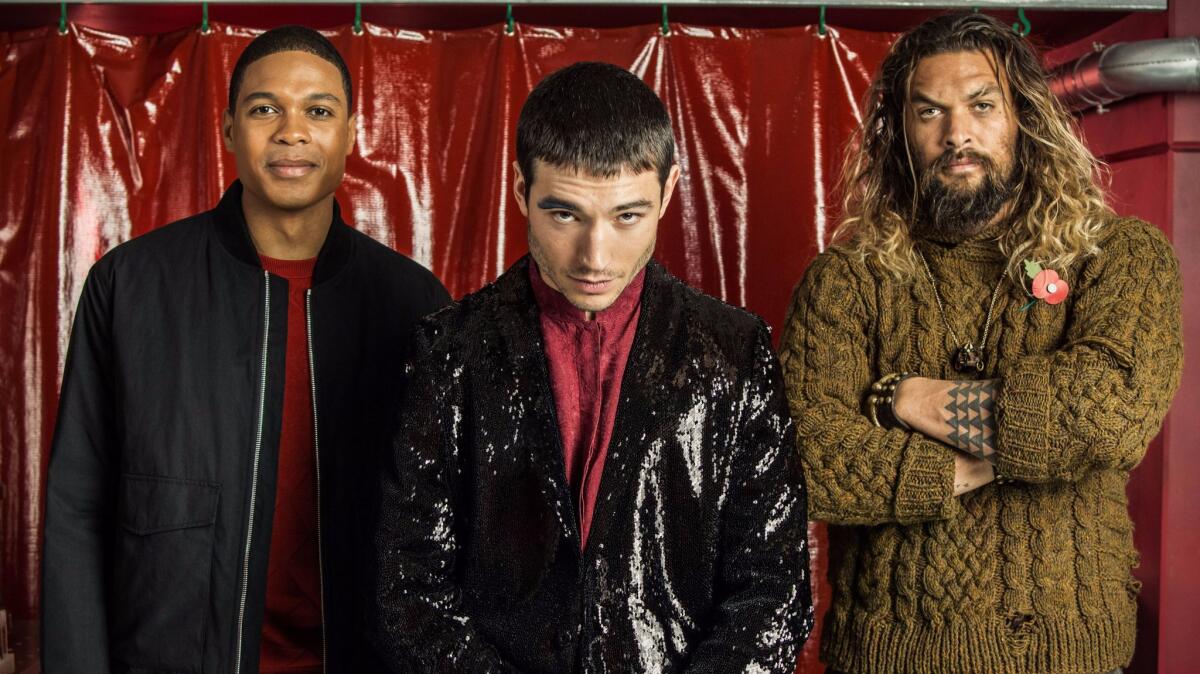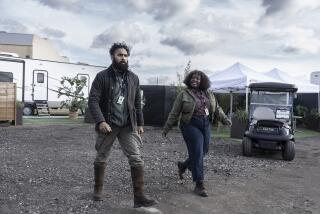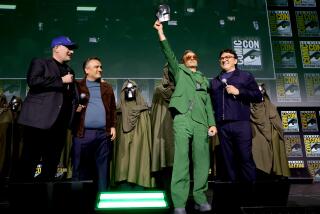New heroes on the block: ‘Justice League’ introduces Aquaman, the Flash and Cyborg

Reporting from London — Several years ago, on a Sunday evening, “Justice League” director Zack Snyder discovered a superhero in a not-so-unlikely place.
“We’re big ‘Game of Thrones’ fans,” explains Deborah Snyder, Zack’s wife and producing partner. “I remember Jason Momoa [as Dothraki chieftain Khal Drogo]. Zack was like, ‘Jason would be the perfect Aquaman.’ I was like, ‘It’s so out of the box. But yeah!’ He can be tough. And he feels like he comes from the water.”
DC and Warner Bros. announced Momoa as Arthur Curry, the Atlantean king and underwater hero, more than three years ago, planning to introduce him in “Batman v Superman: Dawn of Justice.” Although the three metahumans who join Batman and Wonder Woman in “Justice League” didn’t figure into the plot of the 2016 Superman sequel, the filmmakers wanted to give fans a glimpse of their upcoming versions of Aquaman, the Flash and Cyborg.
They shot one scene of Momoa as Aquaman, and then enlisted Ray Fisher as Cyborg and Ezra Miller as the Flash during production of “Dawn of Justice.”
“It was a learning experience because we actually shot that underwater,” Deborah says. “After we shot it Zack said, ‘Are you kidding me? We can’t shoot all these [underwater] scenes.’ It gave us a chance to say, ‘How are we going to do Cyborg? Is he going to be mechanical?’ It was a way to start testing a little bit. We were able to hone in on it when we came to ‘Justice League.’”
For both Zack Snyder and the producers, it was important to find actors who could embody iconic comic book roles, but it was also essential to consider the performers as people.
“For movies with these superheroes you have a lot of kids [watching] and they become role models for kids,” Deborah notes. “They become role models for adults too, but what’s different for the kids is they can’t necessarily distinguish between the character and the actor. Casting the person who was going to play the role was really important to us because it means a lot more. It’s not like a typical role an actor has. It’s magical when it works.”
“The casting of all three of them was pretty inspired,” adds producer Charles Roven. “It was interesting that we ended up, without knowing it, having guys who brought so much of themselves into the characters and have it fit so perfectly.”
And the pressure was on because not only would the actors become part of the superhero supergroup in “Justice League,” but the expectation is that each would ultimately headline his own film as well. Momoa’s “Aquaman” is due out next year. A standalone Flash movie has hit multiple stumbling blocks as directors Seth Grahame-Smith and Rick Famuyiwa both dropped out due to creative differences.
Assembled for the film’s press tour in London (where Miller is currently filming the sequel to “Fantastic Beasts and Where to Find Them”), Momoa, Fisher and Miller spoke to The Times about the status of those projects, their “Justice League” experience and the importance of superheroes in today’s world. The movie opens Nov. 16.
As newcomers to this massive franchise, did you spend a lot of time together? Your producers admitted there was some pranking go on during production.
EM: Minor. We kept it minor. Jason is known to be a prankster with no limits. So you didn’t want to push him even towards the edge because you find out there is no edge.
RF: We had some really good times on set. There was one point where I had a life-size cut-out of myself and I put it in Ezra’s pop-up tent on set and for the life of me I could not get him to go back to his tent. I had to try to convince all his friends who were on set with him. I had to be like, ‘Hey, get him to his tent. I want this thing to scare the ... out of him.’
EM: You corrupted my crew to attempt to get me back to my tent.
RF: To get me back, Ezra pasted his face entirely all over my trailer. I go back to my trailer and there were just Xeroxed copies of Ezra’s face.
EM: We’re talking floor to ceiling, wall to wall.
RF: Everywhere. In the bathroom. On my bed.
EM: I was making a really maniacal expression. No surface area was spared.
So it’s safe to say you guys got along pretty immediately.
EM: Yeah, for sure. There wasn’t really a hiccup in that at any point I can say, honestly. This has been an enjoyable camaraderie throughout the whole process. Sometimes people are real jerks and they can really get in the way of the fluidity of a production by getting caught up in their own needs or discomforts or egos. And there was nothing remotely like that at any point during this process.
JM: You need that support too. Because we have long hours – it took a long time to get to the studio and I had to be in makeup for [Aquaman’s] tattoos and we had to work too. So we’re together a lot. I’m a big fan of ‘the dog needs a bone at the end of the day.’ You need to celebrate a little bit. I’d say, ‘It’s been a good day so would anyone like to come have the bone with me?’
EM: People always say, ‘Yes, Jason, of course we want the bone with you.’
How did it feel to enter a pre-established universe that has existed in several films already?
RF: It’s nice because you get to know what you’re stepping into when you sign on. I can imagine signing on to this thing without having any idea of who the director was or where they were going with things. But after seeing ‘Man of Steel’ [I understood] Zack’s vision for superhero movies that also have consequences and also have superheroes that are complicated. Because I think our superheroes need to be as complicated as the world we live in and, as we know, the world is very complicated.
I think our superheroes need to be as complicated as the world we live in and, as we know, the world is very complicated.
— Ray Fisher
How much changed from the early versions of the script to the finished film?
RF: The script evolved even while we were shooting. I got the privilege of being able to work with [screenwriter] Chris Terrio and see what he was doing at a very early stage. I was in New York, he was in New York. He’s one of the smartest people I think I’ve ever met.
It became a public story that due to a personal tragedy, Zack Snyder had to step away from the project and co-writer Joss Whedon came aboard to finish scheduled reshoots. When that happened, did Whedon give you any new insight into the characters?
EM: That’s not really what Joss was there for. Joss was there to fulfill the vision we’d all cultivated together. You have to envision that it’s a year or so after we’d started the process of shooting — after we’d been preparing our characters, for some of us, years prior. So there was some solidity to those characters at the point where Joss was entering the mix to pull it all together. Which he did with an incredible skill and professionality.

Trailer for Warner Bros. superhero mashup, “Justice League.”
For each of you, what does a superhero mean in 2017?
EM: What fascinates me about superheroes is the timeless nature of this type of storytelling and this type of symbolism. I’m into the fact that in the year ’17 — or the year negative 2017 — there were people who invested energy into pantheons of meta-humans and demi-gods as a way to understand the vastly multifaceted realities of our own psyches. And as a way to remind ourselves of what we naturally possess, which is the ability to defy the limitations we perceive.
JM: Boy, Ezra. I concur.
RF: But 2017 I think there’s the idea — and they play the song in the trailer — that we can be heroes. We just have to be heroes in our own way. It’s the idea that being a hero is difficult. There are choices you have to make. You have to sacrifice yourself. If you’re able to be good and do good all the time and it doesn’t cost you a thing, that’s not real life. People have these false expectations that it’s always going to be easy. While these heroes are super important I think it’s equally important to say, ‘It’s OK not to know what the right thing is as long as you are attempting it. And it’s OK not to do it on this epic scale as long as you’re doing just your part, whatever that is.’ You have billions of people on the planet who could just do a little bit and then we’re good.
EM: And defy their limitations. Like superheroes defy their limitations in physics — normal people defy limitations all the time of what they feel they shouldn’t or can’t or wouldn’t ever do. If you defy those limitations and you do that with a positive purpose, you are a superhero. Even if you’re not breaking some law of physics, because you’re breaking a social construct or a stigma.
Is there a particular importance to telling a story about cooperation at this point in time?
RF: Absolutely. And I think it will be important to infinity and beyond. As we get closer with communication we actually get a little more separate in our ideas. People are more binary in their thinking – things are either black or white. But there are actually so many shades of gray. And the idea of collaborating in this world — because we are dealing with consequences such as global warming and climate change and violence around the world, and sexual harassment — if we were able to talk more and talk to one another, we would find those leagues.
EM: Can we listen? Can we listen to our enemies and realize them to be allies?
RF: And find your common ground with a person. Just because I don’t agree with everything you say doesn’t mean we’re completely opposite.
Do you feel encouraged by the diversity we’re now seeing in superhero films?
RF: For sure. I joke around and call DC Comics “Diversity Comics.” Just by nature of the creative casting that’s happened and the reshaping of different roles. ‘Suicide Squad,’ obviously, was a big example of that. Our film is a big example of that inclusion and diversity. I think representation is important at every level, not just in front of the camera. The people making the decisions – the executives – should also be as diverse as the experiences we’re trying to portray. It has to be on every level otherwise it just becomes a surface level thing. It becomes something that looks diverse, but at the heart of it is not.
EM: I think it’s great, too, that this is the first DC team-up movie on the big screen and the building blocks of it are already so diverse. That sets a precedent for what comes next. As opposed to starting out with a group of white men and then adding other people in later once there’s an angry comment about it. I really feel like DC’s approach is very proactive in that way. And you do see that in our executives all the way down. I see a lot of diversity in our crew and in our cast, and that’s necessary and it’s important. There’s nothing to suggest anything but that that pattern will continue going forward as this universe is continuing to grow.
Jason, we know “Aquaman” is due next year, but what’s the status of the standalone movies for Flash and Cyborg?
RF: There’s a lot in development for sure. I think after people see Ezra’s performance they’ll be banging down the door for a Flash film.
JM: I giggled so much. It’s so fun to belly up and laugh when your friends are just killing it. Flash is amazing.
EM: I think there’s going to be a huge demand for Cyborg’s film as well because of the emotional gravity this brings. It’s what we find in the Nolan Batman movies. Ray brings this level of artistry to this role that’s so exciting. Look, we never know anything. To be perfectly honest with you, they keep us in the dark.
More to Read
Only good movies
Get the Indie Focus newsletter, Mark Olsen's weekly guide to the world of cinema.
You may occasionally receive promotional content from the Los Angeles Times.










